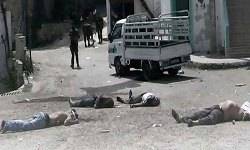The pictures appear to tell a familiar story. In one a pile of bodies lies on a street corner, shot down, apparently where they were gathered. Among them is a girl in a red blouse, perhaps five years old, spread-eagled among a dozen other family members, some covered in sheets. A baby's legs are visible and a crumpled man has apparently been shot through the spine.
According to Syrian opposition activists, these killings happened in the coastal city of Banias, a Sunni family gunned down in the midst of the Alawite heartland, the Shia minority sect largely loyal to the regime of President Bashar al-Assad. Although the pictures could not immediately be verified, video and other pictures appeared to confirm reports of whole families being killed in many massacres by a pro-government militia in the past days, prompting thousands to attempt to flee the area. In a statement, the US State Department said it was "appalled" by the latest reports.
According to reports, the first incident is alleged to have taken place in the village of Bayda on Thursday, while overnight fresh killings were reported by activists inside Banias itself, blamed on gangs of pro-regime loyalists. Images claimed to have been taken in Bayda on Thursday showed the bodies of several men, some apparently blindfolded, lying in the street.
Confirming violence in the area, Syrian state television said it had fought back against "terrorist groups" to restore security and showed what it said was a large cache of weapons seized during the fighting. A video posted online by activists appeared to show what was said to be the bodies of 20 people in the town, all from the same family, killings blamed on the National Defense Forces, a new paramilitary group made up mostly of fighters from minorities that back Assad.
Along with the cities of Tartus and Latakia, Banias – which has seen relatively little violence – is at the center of the Alawite "heartland", referring to the minority Shia sect of which Assad and many of his closest supporters are members. Some analysts have speculated that, in the event of the breakup of Syria, the Assad regime and Alawites might attempt to set up their own mini-state in this coastal strip.
According to some sources, Sunni families were being blocked from fleeing south to the town of Tartus at government checkpoints.
Although the first attacks by pro-Assad shabiha gangs on Sunnis took place in Banias in the first few months of the conflict, it has not seen the same destructive violence that has afflicted other Syrian towns and cities.
The British-based Syrian Observatory for Human Rights claimed that around 4,000 people were fleeing from the predominantly Sunni southern parts of the Mediterranean city of Banias amid fears that pro-government gunmen "might commit a massacre". It said that at least 10 people, including children, were killed on Friday and that the number could be as high at 60. According to some sources, Sunni families were being blocked from fleeing south to the town of Tartus at government checkpoints.
Amateur video showed a man and at least three children dead inside a room in Bayda, a neighboring village overrun by regime forces on Thursday, showing a baby with burned legs and a body stained with blood. Next to him was a young girl whose face had been deformed after apparently being hit with sharp metal.
The latest incident appears to underline the increasingly sectarian nature of a conflict that has pitted a largely Sunni opposition against an Alawite-dominated regime supported by Shia Iran and its ally, Hezbollah.
Last week Hezbollah's head, Hassan Nasrallah, warned the west, Israel and Islamic countries that the Assad regime had friends who would not allow it to fall.
The Observatory said security forces were checking people's identity cards and asking them to return to Banias so that the situation could appear normal.
Syria's crisis, which began in March 2011 with pro-democracy protests and later turned into a war that has killed an estimated 70,000 people, has largely broken along sectarian lines.
The Sunni majority forms the backbone of the revolution, while Assad's minority Alawite sect, an offshoot of Shia, anchors the regime's security services and the military's officer corps.
Other minorities, such as Christians, largely support Assad or stand on the sidelines.
The killings took place as Syrian state TV showed images of Assad visiting a Damascus campus, his second public appearance in a week, seeming to confirm reports of increasing confidence within the regime as it has launched a counter-offensive in both opposition suburbs of the capital and in the city of Homs.
PHOTO CAPTION
Syrian regime troops (in background) with bodies in a street in the Sunni village of Bayda. Photograph: AP
Source: The Guardian


 Home
Home Discover Islam
Discover Islam Quran Recitations
Quran Recitations Lectures
Lectures
 Fatwa
Fatwa Articles
Articles Fiqh
Fiqh E-Books
E-Books Boys & Girls
Boys & Girls  Ramadan
Ramadan Fatwa Audios
Fatwa Audios Month of Mercy
Month of Mercy Women
Women Eed Al- Fitr
Eed Al- Fitr Food Recipes
Food Recipes Videos
Videos

 Prayer Times
Prayer Times












